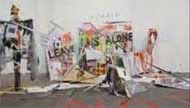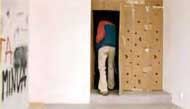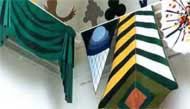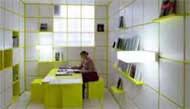|
Archive
albb 2010
albb 2009
albb 2008
albb 2007
albb 2006
albb 2005
about albb
talks
residency
projects/events/exhibitions
open archive & reading room
internships
Contact
Links
Vietnam
Motoko Uda
Sue Hajdu
Galerie Quynh
Nguyen Nhu Huy
Himiko Saloon
Ryllega Gallery
Salon Natasha
Diacritic.org
Atelier Wonderful
Overseas
OLO
Pasi Karjula
forestcamp
Marko Vuokola
Sten Are Sandbeck
Minna Heikinaho
Com-pa-ny
Bank & Rau
AVPD
frame-fund
HAKOtte?
Sendai ArtCity
Philip Brophy.com
Katrin Paul.com
broadsheet
SASCA
womanifesto
trans urban
X-CHANGE culture-science
Asia Art Archive (AAA)
Arts Network Asia (ANA)
Art Autonomy Newtwork (AAN)
Cemeti Art House
the house of natural fiber
Para/Site
Juliana Yasin
|
a little blah blah (albb) is an artists' initiative that since 2005 has operated as a platform for contemporary art through a wide range of channels including projects, exhibitions & events, screenings, talks, a residency program, internships and an open-access archive of art books & catalogues. Our program has evolved in a pioneering spirit, in response to the gaps and needs of the Saigon art scene. Since 2008 we have re-focussed our program to presenting one major project each year, capacity building and the ongoing running of albb Reading Room.
|
SUPER STRUCTURES
|
|

Download PDF: Super Structures project information
Download PDF: Super Structures Thong Tin
|
|
albb is pleased to present its major project for 2008: SUPER STRUCTURES, which will take place from late August, through to November, 2008.
Collaborative projects hit the streets of Ho Chi Minh City, with artists & designers from Finland, Norway, Sweden & Denmark. Arriving into Vietnam's largest, most intense hub of social and urban change, they have two short weeks to respond to the immediacy of being here.
Super Structures takes the physical grid, the social and economic systems of the city as the starting point. Art is live and responsive, even spontaneous, as localities are scouted, surveyed, negotiated. What are the potentialities of this site & system? What could be infiltrated, grafted or discreetly super-imposed? Will art function as an alien body, an imposition, an irrelevance or a contribution?
Collaboration is an important feature of this laboratory. Participating artists are either collaborative units or will create temporary collaborative structures locally.
This project is curated by Sue Hajdu and Pontus Kyander (see bio details below).
|
SUPER STRUCTURES
Presentation, Phase I
|
|
OLO, Sten Are Sandbeck, Minna Heikinaho and COMPANY arrived in Ho Chi Minh City in late August to launch SUPER STRUCTURES. Their work in Saigon was presented at Himiko Visual Cafe for two weeks from Saturday September 6 in a presentation format. Slide shows of the processes involved in SUPER STRUCTURES, together with a small library of catalogues by the artists and albb were also on show. Some 80 people came to take a look at what the artists had been doing and to chat with the artists and curators, and together we celebrated the successful conclusion on Phase I of the project.



image credits:
a. all photos: Tomoko Nishizawa
b. from left: Vu Anh Thu / Vu Anh Thu / Wakako Iguchi
c. from left: Vu Anh Thu / Vu Anh Thu / Tomoko Nishizawa
|
Artists' Projects
|
OLO
OLO No: 45
Circular walks in the streets of HCMC.
Documented on video and still cameras.
|
|
Carrier
Traditional Vietnamese carrying gear
Two mirror balls
Digital color print (100 x 140 cm)
OLO No: 45 took place twice during SUPER STRUCTURES Phase I.
Download PDF: OLO



image credits:
planning: from left: Wakao Iguchi / Tomoko Nishizawa / Sue Hajdu
stills: from left: Tomoko Nishizawa / Wakako Iguchi / Tomoko Nishizawa
audience: from left: OLO / Tomoko Nishizawa / OLO
|
Sten Are Sandbeck
One, 2008
60+12 75 x 38 mm self inking stamps
cardboard box with instructions
wall text
|
|
Sten Are Sandbeck’s project was launched at the SUPER STRUCTURES closing event. 60 large self-inking stamps were offered free to take from a cardboard box placed under a crudely hand painted wall text, reading in Vietnamese: Bạn không thích được vậy sao?, meaning: Wouldn’t you like to be one?. The red imprints appearing from the stamps outline a simple unisex figure: its level of abstraction slightly resembling that of corporate logos or icons.
A sheet of paper on the box containing the stamps stated a short instruction: “Please take a stamp. Make imprints wherever you go around in Ho Chi Minh City. Look out for identical marks.”
Following the launch of Bạn không thích được vậy sao? and the artist’s departure from Ho Chi Minh City small signifiers have started to appear scattered around the city (and beyond), as evidence of the new community of stamps holders.
The graphic symbol can signify group belonging and an adherence or opposition to authority or a certain set of values. As used in both private and public spheres, the sign (as logo or icon) may in some cases detach from its initial context and representation, creating new substructures, and obtaining a life of its own.
Stamps serve to verify the authorization of documents such as certificates and permissions by identifying the institution. Hence, a stamp-imprint may simultaneously signify and empower its own domain.
Download PDF: Sten Are Sandbeck



image credits:
project: Tomoko Nishizawa / Tomoko Nishizawa / Wakako Iguchi / Tomoko Nishizawa / Tomoko Nishizawa
presentation: Tomoko Nishizawa / Vu Anh Thu / Tomoko Nishizawa / Tomoko Nishizawa
evidence: from left: Sue Hajdu / Sten Are Sandbeck / Sten Are Sandbeck
|
Minna Heikinaho
The story of Ho Chi Minh City, 2008
16 minutes
Minidv, PAL
Directed by Minna Heikinaho
Edited by Minna Heikinhao, Tran Cao Nguyen
Shot by Minna Heikinaho, Luong Thu Dung, Tran Cao Nguyen
Interviewees: Tuan Anh, Nguyen Thi Diep, Linh Chi, Nguyen Thi Hong, Bao Loc, Do Hoang Nam, Khac Rat, Nguyen Thi Toi, Thao
|
|
Minna Helikinaho created The story of Ho Chi Minh City, 2008, during SUPER STRUCTURES Phase I and a research trip a few month before. It is part of a series of videos produced around the world in which she interviews participants, asking simple direction questions about their lives and values.
Artist's statement:
Do I "build" my life; what and how?
My inabilities, my relationships with others, with strangers-these things compel me do social things in my work, they make me get closer to a stranger.
In urban projects I work in neighborhoods with local residents and ask questions that relate to local circumstances or personal private values.
In my view, life consists of phases between living and dying. Life is a kind of process determined by how we build it. We can't personally choose our building material, but we can try to fix it or renew it. We are incomplete. Life is a building site that we work in.
Ethics is not obligation towards the Other mediated through the formal and procedural universalization of maxims or some appeal to good conscience; rather - and this is what is truly provocative about Levinas - ethics is lived as oblication to the Other whose form is sensibility. It is because the self is sensible - that is vulnerable, passive, open to wondering, pain, and the movement of the erotic - that is worthy of ethics. Ethics, for Levinas, is enacted at the level of skin.
(The Ethics of Deconstruction, p.180)
In communal activity, the artist is a facilitator who provides the community with a framework, a concept and her or his own artistry.
Here in Ho Chi Minh City I worked in urban space around the city. I am looking at the city as an outsider, a foreigner, a stranger. I want to try to understand a little bit more about your city. So I made my story, The story of Ho Chi Minh City, which is shot, edited and scripted here during the combined four weeks the SUPER STRUCTURES project and a research trip here in June this year. My video gives local neighborhoods one possibility to hear each other's opinions. What do people think about Ho Chi Minh City, what do they miss of past times, wish for the future? What do they want to change in their city? What is the best and the worst of this city? These questions can to give encouragement or inspiration to improve the city for the inhabitants.
As a further part of this project, I also asked questions about more private values such as what religion, love and death mean. These interviews will be edited shortly.
Download PDF: Minna Heikinaho


 image credits:
image credits:
video stills: all images by Tran Cao Nguyen
process: all images by Tomoko Nishizawa
presentation: from left: Vu Anh Thu / Vu Anh Thu / Tomoko Nishizawa / Tomoko Nishizawa
|
COMPANY
Made in Vietnam: A COMPANY Shoe Story
Working title & nick-name: Đôi Mới (new pair of shoes)
|
|
Inspired by local materials and culture, COMPANY developed a number of prototypes and samples of shoes with wooden soles, which were displayed together with items of inspiration during the project presentation. COMPANY will continue the project to the final production stage, working from Helsinki.
Statement:
Hello! We are COMPANY from Helsinki, two of us – Johan & Aamu.
Back home in Helsinki, we both own shoes that were made in Vietnam. Who made these shoes?
Our aim during our two-week stay in Vietnam was to design and produce a shoe, collaborating with local manufacturers. We want to make a sellable product that will benefit both the manufacturer and the designer. Our plan is to keep the manufacturing in Ho Chi Minh City and Binh Duong and to then export the shoe to Helsinki.
After some internet research back in Finland, we got excited about wooden sandals. These suit the hot and humid Vietnamese climate and the Vietnamese proudly wear them in both city and country life. The wooden shoe exists in different versions all around the world and is a product that can definitely be exported.
The process of working on this project here in Ho Chi Minh City involved meeting the makers, learning how their products are made and developing a product together. We documented the process, collected all the names and faces of the manufacturers and are telling the story of how and where this product is made. All designs, prototypes and samples were made in Ho Chi Minh City and Binh Duong province during this two-week period. The final step will be to bring our shoes to the market.
This is the start of the Ho Chi Minh-Helsinki story.
Download PDF: COMPANY



image credits:
research: from left: Wakako Iguchi / Wakako Iguchi / Com-pa-ny / Tomoko Nishizawa
development: from left: Wakako Iguchi /Tomoko Nishizawa / Wakako Iguchi / Wakako Iguchi
the shoes: from left: Wakako Iguchi / Tomoko Nishizawa / Wakako Iguchi
|
Peter Johannson & Barbro Westling
KOLLAPS
theatrical sit-in
sound component
30 minutes
|
|
KOLLAPS engaged a live audience with two big heads in a too small room. Audiences sat in the café table setting of Himiko, listening to the sound and watching the shadowy figures of the artists with their big heads moving slowly around the dark room. At a particular moment, the artists reached out to each individual in the room. This un-modern theatrical sit-in was performed five times with different audiences on the night of the presentation of phase II of SUPER STRUCTURES.
Download PDF: Peter Johannson & Barbro Westling



image credits:
big head: Tomoko Nishizawa
interaction: all images by Tomoko Nishizawa
audience: Tomoko Nishizawa
|
Bank & Rau
Working Vietnam
Project proposal & 5 A4 prints
|
|
Bank & Rau made a research trip to Saigon in 2007, but were not able to travel again to realize their proposal during SUPER STRUCTURES due to funding limitations. Their project proposal, which is closely related to two projects they realized in Copenhagen, Violet Society from 2007 and A Woman’s Touch from 2008, was on view for guests at SUPER STRUCTURES Phase II.
Download PDF: Bank & Rau

image credits:
installation detail: Tomoko Nishizawa
|
AVPD
Transparency, 2007
Project proposal & presentation of Transparency, 2007, PDF documentation
|
|
Due to other commitments, AVPD were not able to travel to Ho Chi Minh City to take part directly in SUPER STRUCTURES. Instead, options were explored to create a version of Transparency in Saigon. Transparency works with layers of clear PVC, presented framed. Unfortunately, local PVC materials were not of a high enough quality to realize this work. Instead, AVPD’s project proposal, together with documentation of Transparency, 2007 were presented framed, on view for guests at SUPER STRUCTURES Phase II.
Statement:
The works of AVPD take their starting point in urban life and the basic conditions for the human perception of time, space, objects and surfaces.
This specific series of works, Transparency, discusses the connection and non-connection between spaces/rooms and persons/objects through different types of transparent, semi-transparent and non-transparent planes in the city-scape such as windows, glass doors, building facades etc. with a strong focus on the the human visual apparatus and the significance of light in the process of perceiving the world.
Download PDF: AVPD

image credits:
audience viewing work: Ngo Dinh Truc
|
Publication of catalogue & guide booklet
|
|

A 104-page full color catalogue was published as a part of this project. The catalogue contains sections on each of the artists’ projects, four catalogue essays, and a guide section to art spaces in the region, covering Phnom Penh, Hue and Hanoi, in addition to Ho Chi Minh City. The guide is useful to artists and curators interested in developing a project in the region, as is the more detailed discussion on the art infrastructure in Vietnam provided in Essay #3 by Viet Le.
Download PDFs - catalogue essays and guide:
Essay #1: Superstructuring by Pontus Kyander, co-curator, SUPER STRUCTURES
Essay #2: Dialog with Difference: Approaching the Saigonese Other by Dr. Ashley Carruthers
Essay #3: Strictures, Superstructures, and Supermodels by Viet Le
Essay #4: Is this a jetlag disaster? Dear God, just get me out of here! by Sue Hajdu, co-curator, SUPER STRUCTURES
>> ART AND SPACE IN THE REGION: A BRIEF GUIDE
|
Participating artists
|

|
OLO
OLO is a collaborative between Helsinki-based artists Pasi Karjula and Marko Vuokola. Despite (or maybe because of) seemingly disparate artistic practices, they have on and off worked together since 1990 with public art projects of both temporary and permanent character. Every project is different in technique and approach, but all named as the same in the OLO series, one of the latest being the buried diamond for Villa de Bank in Enchede, Holland, OLO nr 43.
www.kaapeli.fi/olo
www.vuokola.com
www.kaapeli.fi/karjula/
|

|
Sten Are Sandbeck
Norwegian artist, Sten Are Sandbeck utilises his solid background in painting for spatial, political and social interventions. His works combine a strong feel for nature and the environment with an expressive and existential, sometimes seemingly aggressive style. On closer inspection, however, there is always a hidden, quirky layer of poetry in his works.
www.stenaresandbeck.no
|

|
Peter Johansson & Barbro Westling
Peter Johansson is on his own one of Sweden's most well known artists, with a keen interest for vernacular taste and the crossing between folklore and contemporary culture. Working with Barbro Westling, a well known writer and critic, the duo have ventured into domains of model-theatre, art and economical transactions, and interactions where the roles of performers and audience are merged.
|

|
Minna Heikinaho
Minna Heikinaho has an art practice based on direct social interaction with her environment. She opened her studio during a year-long period as a café in an old working class district in Helsinki, where activities of many sorts took shape. She creates situations, where rigid social structures at least temporarily break down.
www.artists.fi/sculptors/kuvanveistajat/heikinaho/index.htm
|

|
Com-pa-ny
Com-Pa-Ny are Aamu Song and Johan Olin, designers and artists with a very poetic approach to the kinds of objects people actually need to live better and happier lives. Their designs encourage closer relations between people, and between humans and our environment. Based in Helsinki, they are receiving rising international attention in design circles as well as from the art world.
http://com-pa-ny.com
|

|
Bank & Rau
Lone Bank and Tania Rau (formerly of Bank, Malbæk & Rau) have criss-crossed between painting, spatial design and fashion. Often working in spatial installations, the objects they develop have a strongly painterly and ornamental appearance. At the same time they twist depiction and expectations, deliberately reducing objects to two-dimensional flatness. Their projects have an open interface to the audience, often by creating environments that invite the visitors with a leisurely relaxed mood.
www.kunstdk.dk/kunstner/bank_rau
|

|
AVPD
Aslak Vidbæk and Peter Døssing have with quickly rising success developed their artist' formation AVPD into one of Denmark's most acclaimed artistic ventures in recent years. They work in a field between art design and architecture, combining design methods of early computer graphics, mobile and mechanized spatial constructions, and a strong interest in the relations between space, light and mobility. Their projects are often characterized by a cool, almost sci-fi appearance, based on surprisingly low-tech solutions. Many of their works are based on their PSS, Poly Spatial System.
www.avpd.net
|
About the Curators
|
|
Sue Hajdu
Artist, curator, writer. Artistic director, a little blah blah (albb).
Based, HCM City, Vietnam, 2001>>.
Art projects focus on public space, taking on the monumental scale of the city as a whole vs. ephemerality & immateriality, hit-and-run performances, narratives of social relations.
Selected projects: [curatorial] The Bao Loc Project (Bao Loc, Vietnam 2007) [personal] HAKOtte? (Sendai, Japan, 2008 & www.s-a-p.jp/suehajdu), Colorguard Series, (HCMC public space, 2007), MAGMA | we're not counting sheep (HCMC, 2006).
www.suehajdu.com
|
|
Pontus Kyander
Art critic and curator. Guest professor at Ewha University, Seoul Korea.
Public Art Manager at Auckland City Council, New Zealand, Aug. 2008>>.
Selected exhibitions: Domestic Affairs. Five artists from Hong Kong (Malmö 2008), Gustav Metzger, work 2006-7, Lund Konsthall and Zacheta National Gallery of Contemporary Art Warsaw), Seoul: Until Now! (Charlottenborg, Copenhagen 2005), From Dust to Dusk (2003), Ernesto Neto (2002), Sur Face (2001), Waterfront (2000), Nature of Man (1998)
|
Thanks
|
Our thanks to all of the following, whose hard work and generous support have enabled this project to happen:
Co-ordinator: Luong Tu Dung
Project team: Huynh Nguyen Phuong Nguyen / Tran Cao Nguyen / Vo Thanh Lien Anh / Chung Quoc Hung / Ngo Thi Ngoan / Ton That Hoan Vu / Vu Thien Nguyen Phong / Hua Kim Thanh / Nguyen Kim To Lan / Tran Minh Duc
Identity & invitation design: Midori Tomita
Photographers: Nishizawa Tomoko / Wakako Iguchi / Vu Anh Thu / Ngo Dinh Truc
Catalogue contributors: Dr. Ashley Carruthers, Viet Le
Main translator: Tran Minh Duc
Vietnamese editing & proof-reading: Le Thua Tien
Catalogue design & layout: Luong Tu Dung
and: Himiko Visual Cafe and staff / Nguyen Kim Hoang / Do The Binh / Henry Forwood & family / Maritta Nurmi / Pham Chi Mai / Kate Anderson / Roy Hornsby / Noelle Illes / Duy from April / Pham Thi Anh Duong / Cuc Phuong / Mr. Tien from Thanh Tien factory / Mr. Kon Huynh from Mandarin shoes /Mr. Nghi from Lover shoes / Quang Guest House staff / Bao Loc / Vu Khac Rat / Linh Chi / Do Hoang Nam / Tuan Anh, Thao Dao / Chung Ngoc Linh / Nguyen Viet Cuong / Nguyen Thi Diep / Nguyen Thi Hong / Nguyen Thi Toi
This project is generously funded by:

|
|

